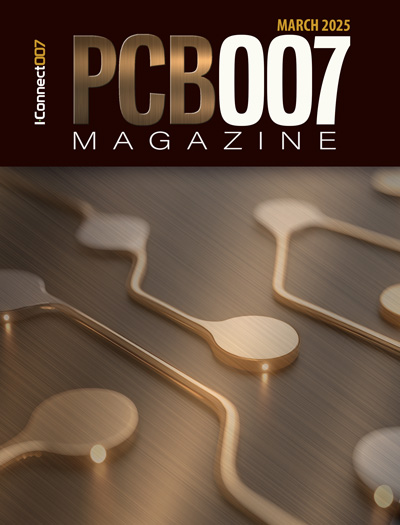-

- News
- Books
Featured Books
- pcb007 Magazine
Latest Issues
Current Issue
Voices of the Industry
We take the pulse of the PCB industry by sharing insights from leading fabricators and suppliers in this month's issue. We've gathered their thoughts on the new U.S. administration, spending, the war in Ukraine, and their most pressing needs. It’s an eye-opening and enlightening look behind the curtain.

The Essential Guide to Surface Finishes
We go back to basics this month with a recount of a little history, and look forward to addressing the many challenges that high density, high frequency, adhesion, SI, and corrosion concerns for harsh environments bring to the fore. We compare and contrast surface finishes by type and application, take a hard look at the many iterations of gold plating, and address palladium as a surface finish.

It's Show Time!
In this month’s issue of PCB007 Magazine we reimagine the possibilities featuring stories all about IPC APEX EXPO 2025—covering what to look forward to, and what you don’t want to miss.
- Articles
- Columns
Search Console
- Links
- Media kit
||| MENU - pcb007 Magazine
How to Discover and Equip the Next Generation of Talent
February 18, 2025 | Stephen V. Chavez, Siemens EDAEstimated reading time: 1 minute
The demand for skilled PCB designers is at an all-time high, with one-third of engineering jobs in the United States going unfilled. Addressing this talent gap involves solving two interconnected challenges: discovering where to find the next generation of PCB designers and equipping them with the necessary skills to thrive in a rapidly evolving field. These two efforts are fundamentally linked and require a strategic approach that bridges education, mentorship, and innovation.
Where Will We Find the PCB Designers of the Future?
· High school outreach and engagement: One promising avenue is early exposure. High schools can be fertile ground for identifying and cultivating young talent, especially if we make PCB design accessible and relatable. Framing design as a creative, problem-solving discipline that is not unlike the strategies and skills used in video games can capture students’ imaginations. Interactive workshops, hackathons, and design competitions tailored to younger generations could demystify the field and demonstrate its relevance to everyday life and its potential as a very fruitful career choice. A good example of fostering the new generations is the national program such as FIRST (For Inspiration and Recognition of Science and Technology), a global nonprofit 501(c)3 organization that prepares young people for the future through a suite of inclusive, team-based robotics programs for ages 4-18 (grades preK-12).
· Apprenticeships and internships: Apprenticeships provide a hands-on approach to learning that complements theoretical education. By partnering with local businesses, trade schools, and colleges, companies can offer real-world experience to young people. This model not only fills immediate staffing needs but also nurtures long-term talent pipelines.
To continue reading this article, which originally appeared in the February 2025 Design007 Magazine, click here.
Suggested Items
New Issue of Design007 Magazine: Are Your Data Packages Less Than Ideal?
05/09/2025 | I-Connect007 Editorial TeamWhy is it so difficult to create the ideal data package? Many of these simple errors can be alleviated by paying attention to detail—and knowing what issues to look out for. So, this month, our experts weigh in on the best practices for creating the ideal data package for your design.
RF PCB Design Tips and Tricks
05/08/2025 | Cherie Litson, EPTAC MIT CID/CID+There are many great books, videos, and information online about designing PCBs for RF circuits. A few of my favorite RF sources are Hans Rosenberg, Stephen Chavez, and Rick Hartley, but there are many more. These PCB design engineers have a very good perspective on what it takes to take an RF design from schematic concept to PCB layout.
The Right Blend: Mixed Wireless Technologies
05/08/2025 | Kirsten Zima, Siemens EDAA common trend recently is to employ as many radios as possible on a single PCB. With the increase of wireless standards and the downscaling of PCB size, it can be difficult to know what the most critical design parameters are to focus on. In this article, we’ll discuss the most important considerations to make when designing with mixed wireless technologies, such as Bluetooth, GPS, and Wi-Fi, on a single PCB. These considerations include antennas, frequencies, FCC compliance, shielding, and layout with and without transition vias.
Navigating Global Manufacturing in an Era of Uncertainty
05/07/2025 | Philip Stoten, ScoopThe EMS industry faces unprecedented challenges as global trade tensions rise and tariff announcements create market uncertainty. In an overview of IPC Europe’s podcast, MADE IN EUROPE, industry experts from GPV and Zollner examine how these developments impact our businesses and customers, and what strategies will prevail in this new landscape.
Voices of the Industry: Alpha Circuit
05/06/2025 | Marcy LaRont, PCB007 MagazinePrashant Patel, founder and president of Alpha Circuit, takes a pragmatic approach to doing business: “Commerce always wins out,” he says. How will potential tariffs and shifts in the economy affect PCB manufacturing? Prashant offers sound advice.


